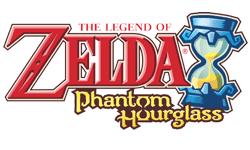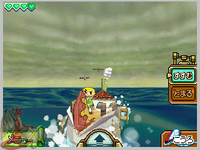|
|

|
PLATFORM
|
Nintendo DS
|
BATTLE SYSTEM
|

|
INTERACTION
|

|
ORIGINALITY
|

|
STORY
|

|
MUSIC & SOUND
|

|
VISUALS
|

|
CHALLENGE
|
Easy to Moderate
|
COMPLETION TIME
|
15-20 Hours
|
|
OVERALL

|
Click here for scoring definitions
|
|
|
Nintendo certainly has a lot of first-party franchises that have been, and continue to be, favorites for gamers of all ages. In the adventure genre The Legend of Zelda series has been around for slightly over 20 years, and shows no signs of stopping any time soon. Not too long ago the first entry for the series on the Nintendo DS was released in Japan. The Legend of Zelda: Phantom Hourglass is a solid addition and a good direct sequel to Wind Waker. While the game suffers a bit due to its over-reliance on the stylus, it is a fun and engrossing title with a few unique tweaks of its own.
As mentioned above, the battle system is a definite departure from previous titles in that it entirely relies on the use of the stylus. Using the stylus does provide a few extra options, such as much more precise handling of favorite Link utiltites like bombs, arrows, and the like. Where it lacks is that there is no option for using the directional pad to control Link at all. Use of the pad is limited to opening up status menus and maps, which is a disappointment. As great as the stylus is for the DS, it is limiting in that it is the only option in the battle system.
Where use of the stylus does shine is in the game's interaction, especially with handling the maps and creating memos. Some clues that are vital for progressing in the game involve symbols or specific locations that players need to jot down or memorize. Why bother with pen or paper when you can directly write those clues on the game map? Also, several scenarios in the game require players to actually shout or blow into the microphone to deal with certain puzzles. While the latter example may be more of a gimmick than anything, it shows that the producers of the game wanted to use the features of the DS as much as possible, and it makes for an impressive product.
 Stormy weather...
Stormy weather...
|
|
Storywise, Phantom Hourglass is a direct continuation of Wind Waker with the events of the game literally following right after the end of the previous Gamecube title. Tetra, the pirate captain from the previous title, is heavily involved in the plot, as well as a few other characters. As a stand-alone title, the game does fine on its own, as Zelda games usually do fine on their own merits with fighting and puzzles.
In addition to the story, Phantom Hourglass also carries on the visuals of Wind Waker. The cel-shaded designs are maintained as much as possible on the platform, and fans of Wind Waker will be happy to see them return for a second showing. There are a couple of in-game cinemas which help advance the story, but they generally take a back seat to the visuals of the game itself, which are pretty solid when compared to other DS titles. Musically, there aren't too many standout tracks, although the usual Zelda themes are kept of course. Those along with Link's yells and silent protagonist actions are kept intact, adding to the atmosphere of the game.
 Eeeeyah!
Eeeeyah!
|
|
As a Zelda game, most of the difficulty is within the puzzles, which are difficult but by no means impossible to solve. For gamers wishing to brave the Japanese version of the game, there is one particular feature which is of incredible use. While there are a decent amount of kanji in the dialogue, gamers that want to check the readings of each kanji may do so by pressing the stylus over the text, thereby bringing up the furigana, or character readings of those kanji. Adoption of this feature is understandable given the wide age range of gamers playing the Zelda series, although its use for non-Japanese gamers trying to decipher the text, study the language (or both) is invaluable, and a great use of the DS's capabilties.
Overall, this a good addition to the extensive Zelda canon, though not perfect along the lines of Ocarina of Time or the like. The overuse of the stylus in the battle system is a limitation and can get annoying if you are not a fan of using it, but the interaction features make up for it. On the positive side, there is a multi-player game which has capture-the-flag elements to it, and is great fun to play in addition to the regular game. No doubt there will be modifications made to the game in order to localize it for North American release, but from the looks of the Japanese version it looks like the DS has a great addition to one of Nintendo's oldest running series. It's worth taking a look; more so if you're already a fan of The Legend of Zelda series.
Review Archives
|









